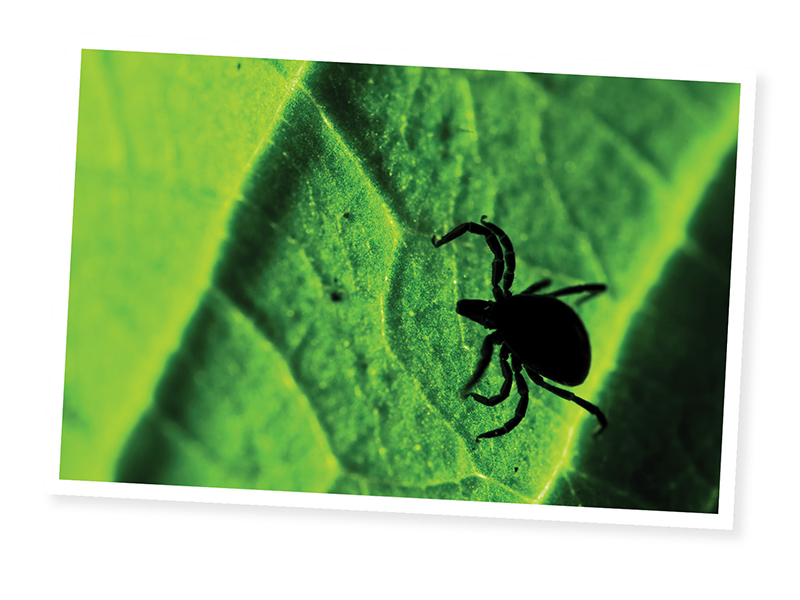What You Need to Know About Ticks and Lyme Disease
In 2010, my father experienced an abrupt and mysterious transformation. Almost overnight, he went from walking seven miles a day to struggling to get out of bed. His joints became extremely sore and an overwhelming fatigue made it hard for him to get through his daily routine. Then, my brother began experiencing the same symptoms. The culprit was smaller than a grain of rice: a tick.
My father and brother joined an estimated 300,000 people in the United States diagnosed with Lyme disease, according to the most recent reports from the U.S. Centers for Disease Control and Prevention. Timing for their infection was prime. In 2011, Virginia health officials warned residents to be aware of the increase in cases of Lyme disease spreading southward and westward from the northern regions of Virginia.
While there are a number of different types of ticks, only one can transmit Lyme: the blacklegged tick. The cycle for Lyme transmission actually starts with young nymph ticks; adult blacklegged ticks seldom bite people. Adult blacklegged ticks, looking to acquire nutrition for their eggs, will feed on the blood of deer.
“Adult ticks will congregate and it becomes kind of like a Carnival cruise on the deer,” explains David Gaines, state public health entomologist with the Virginia Department of Health. “However, deer are not a reservoir of Lyme. Their blood actually destroys the Lyme agent.”
Lyme comes into play when larval ticks hatch and feed on infected white-footed mice. Infected larvae become nymphs which go on to infect people or other animals, typically during spring and early summer.
“A lot of people have the misconception that you get tick bites in grassy areas, but the danger is grass in shaded areas, like a forest, not in sunny fields,” Gaines says. He adds that ticks do not drop out of trees. They are most likely found on sticks or tree stumps at foot level, where bites often occur.
Symptoms of infection can vary. Often present is an erythema multiforme, or EM, rash with a characteristic red bull’s-eye sore. Other symptoms might include fever, joint swelling, fatigue, headache, and dizziness, and can in some cases manifest to arthritis and neurological or cardiac problems.
A Lyme diagnosis typically includes a combination of laboratory work and description of symptoms. Doctors might prescribe a 14-day period of antibiotics. IV antibiotics might be administered for more serious cases. Some people never have symptoms from an infected tick bite whereas others go on to have chronic, long-term issues.
Myra Holt, a nurse, was diagnosed with Lyme about six years ago and travels to Pennsylvania every four to six months for treatment. She now leads the Hampton Roads chapter of the National Capital Lyme Association, which provides support for those affected with the disease.
“For some people, it’s a constant battle. You have to be your own advocate,” Holt says. “We try to give those people that come to the support group hope. We discuss our stories and things like treatments that worked for one another.” Holt is an advocate of education and staying positive emphasizing, “The more you learn, the more it’ll help you.”
NatCapLyme support group meetings are held on the second Tuesday of every month at the New Life Providence Church in Virginia Beach.
Luckily, there are ways to protect yourself from tick bites. Gaines suggests dressing properly, wearing repellant treated clothes, and using repellant on your skin. If you anticipate being in moist, shaded areas where ticks thrive, tuck your pants into your socks; or, make sure to apply a band of skin insect repellant along each leg if you’re wearing shorts. You can pre-treat clothing with permethrin-based sprays (not to be applied to skin) which actually kill ticks.
Even if you’ve taken all precautions, Gaines suggests that, “After one has been in these environments, it’s always good to do a once over tick check.”
Outlook
Recent estimates show around 300,000 people diagnosed with Lyme disease in the United States. The majority of reported cases are in the Northeast and Midwest regions of the country, with 96 percent of reported cases occurring in 13 states—Virginia being one of them.
Things to Know
- Animals can get Lyme, too. Dogs are 50 percent more likely to get the disease than people.
- Children ages 5-14 are at the highest risk of acquiring Lyme disease.
- Symptoms of Lyme can occur days or months after an infected bite.
- Peak season for Lyme transmission is May through July, when nymphal deer ticks are feeding.
- If you do find a tick on yourself, remove it with tweezers and store it in a vial of alcohol for future identification should you become sick.
Protect Yourself
- Try to avoid prolonged periods in tick habitats.
- Wear repellents, like DEET or picaridin on exposed skin, and permethrin on clothing and shoes.
- Wear light colored clothing to make identifying ticks easier.
- Do a clothing and body tick check after spending time in shaded areas.
- Remove ticks as soon as possible when found—transmission of disease may require hours or days of feeding, so prompt tick removal can reduce the chance of infection.

